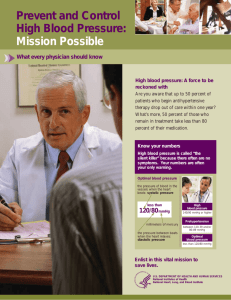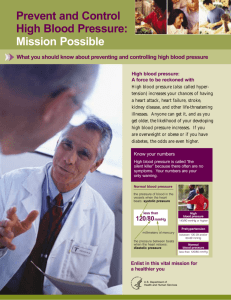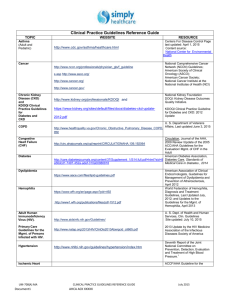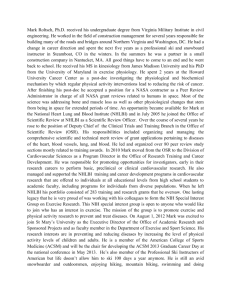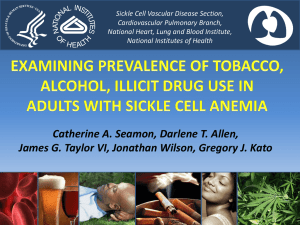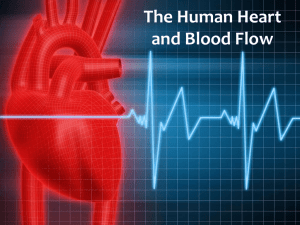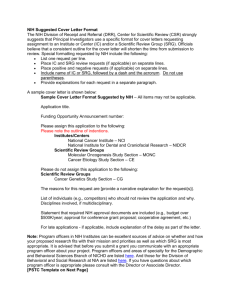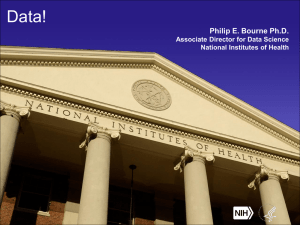National Heart, Lung, and Blood Institute (NHLBI)
advertisement
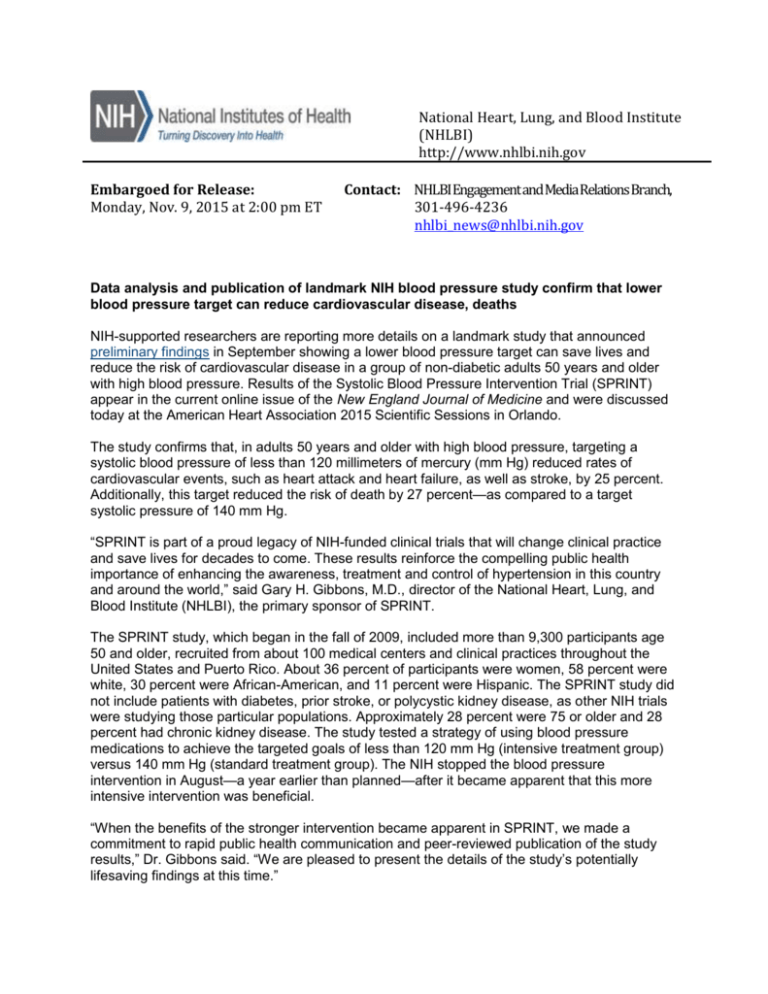
National Heart, Lung, and Blood Institute (NHLBI) http://www.nhlbi.nih.gov Embargoed for Release: Monday, Nov. 9, 2015 at 2:00 pm ET Contact: NHLBI Engagement and Media Relations Branch, 301-496-4236 nhlbi_news@nhlbi.nih.gov Data analysis and publication of landmark NIH blood pressure study confirm that lower blood pressure target can reduce cardiovascular disease, deaths NIH-supported researchers are reporting more details on a landmark study that announced preliminary findings in September showing a lower blood pressure target can save lives and reduce the risk of cardiovascular disease in a group of non-diabetic adults 50 years and older with high blood pressure. Results of the Systolic Blood Pressure Intervention Trial (SPRINT) appear in the current online issue of the New England Journal of Medicine and were discussed today at the American Heart Association 2015 Scientific Sessions in Orlando. The study confirms that, in adults 50 years and older with high blood pressure, targeting a systolic blood pressure of less than 120 millimeters of mercury (mm Hg) reduced rates of cardiovascular events, such as heart attack and heart failure, as well as stroke, by 25 percent. Additionally, this target reduced the risk of death by 27 percent—as compared to a target systolic pressure of 140 mm Hg. “SPRINT is part of a proud legacy of NIH-funded clinical trials that will change clinical practice and save lives for decades to come. These results reinforce the compelling public health importance of enhancing the awareness, treatment and control of hypertension in this country and around the world,” said Gary H. Gibbons, M.D., director of the National Heart, Lung, and Blood Institute (NHLBI), the primary sponsor of SPRINT. The SPRINT study, which began in the fall of 2009, included more than 9,300 participants age 50 and older, recruited from about 100 medical centers and clinical practices throughout the United States and Puerto Rico. About 36 percent of participants were women, 58 percent were white, 30 percent were African-American, and 11 percent were Hispanic. The SPRINT study did not include patients with diabetes, prior stroke, or polycystic kidney disease, as other NIH trials were studying those particular populations. Approximately 28 percent were 75 or older and 28 percent had chronic kidney disease. The study tested a strategy of using blood pressure medications to achieve the targeted goals of less than 120 mm Hg (intensive treatment group) versus 140 mm Hg (standard treatment group). The NIH stopped the blood pressure intervention in August—a year earlier than planned—after it became apparent that this more intensive intervention was beneficial. “When the benefits of the stronger intervention became apparent in SPRINT, we made a commitment to rapid public health communication and peer-reviewed publication of the study results,” Dr. Gibbons said. “We are pleased to present the details of the study’s potentially lifesaving findings at this time.” In their report, investigators provided detailed data showing that both cardiovascular deaths and overall deaths were lower in the intensive treatment group. Certain types of serious consequences were more common in the intensive group, including low blood pressure, fainting, electrolyte abnormalities, and acute kidney damage. However, other serious adverse events associated with lower blood pressure, such as slow heart rate and falls with injuries, did not increase in the intensive group. In patients with chronic kidney disease, there was no difference in the rate of serious decline in kidney function between the two blood pressure goal groups. “The benefits of more intensive blood pressure lowering exceeded the potential for harm, regardless of gender or race/ethnicity,” said study co-author Paul Whelton, M.D., of Tulane University School of Public Health and Tropical Medicine in New Orleans, Louisiana. He is chair of the SPRINT Steering Committee. In addition to its primary cardiovascular outcome, the study continues to examine kidney disease, cognitive function, and dementia among the SPRINT participants; however, these results are not yet available as additional information will be collected and analyzed over the next year. “Although the study provides strong evidence that a lower blood pressure target saves lives, patients and their health care providers may want to wait to see how guideline groups incorporate this study and other scientific reports into any future hypertension guidelines. In the meantime, patients should talk to their health care providers to determine whether this lower goal is best for their individual care,” said study co-author Lawrence Fine, M.D., Chief, Clinical Applications and Prevention Branch at NHLBI. “It’s also important to remember that healthy lifestyle changes can make a difference in controlling high blood pressure,” Dr. Fine added. He emphasized the importance of following a healthy diet, being physically active, maintaining a healthy weight, as well as learning to check your blood pressure. In addition to primary sponsorship by the NHLBI, SPRINT is co-sponsored by the NIH’s National Institute of Diabetes and Digestive and Kidney Diseases, the National Institute of Neurological Disorders and Stroke, and the National Institute on Aging. ### Part of the National Institutes of Health, the National Heart, Lung, and Blood Institute (NHLBI) plans, conducts, and supports research related to the causes, prevention, diagnosis, and treatment of heart, blood vessel, lung, and blood diseases; and sleep disorders. The Institute also administers national health education campaigns on women and heart disease, healthy weight for children, and other topics. NHLBI press releases and other materials are available online at http://www.nhlbi.nih.gov. About the National Institutes of Health (NIH): NIH, the nation's medical research agency, includes 27 Institutes and Centers and is a component of the U.S. Department of Health and Human Services. NIH is the primary federal agency conducting and supporting basic, clinical, and translational medical research, and is investigating the causes, treatments, and cures for both common and rare diseases. For more information about NIH and its programs, visit www.nih.gov. NIH...Turning Discovery Into Health
